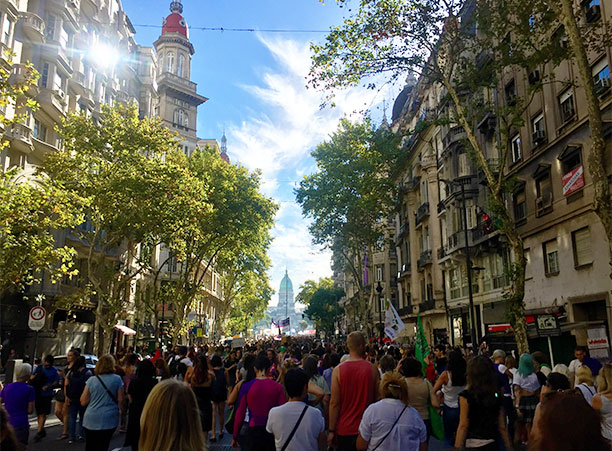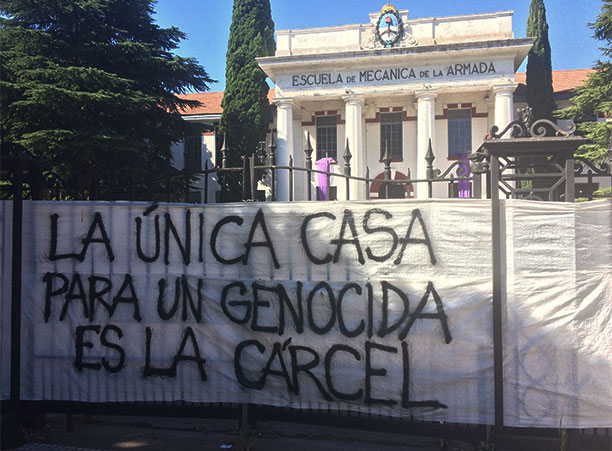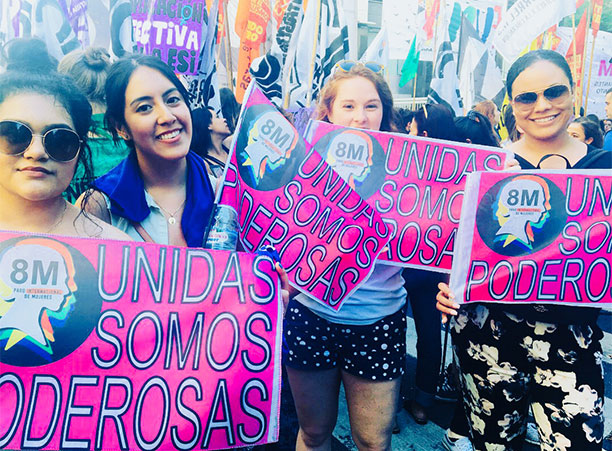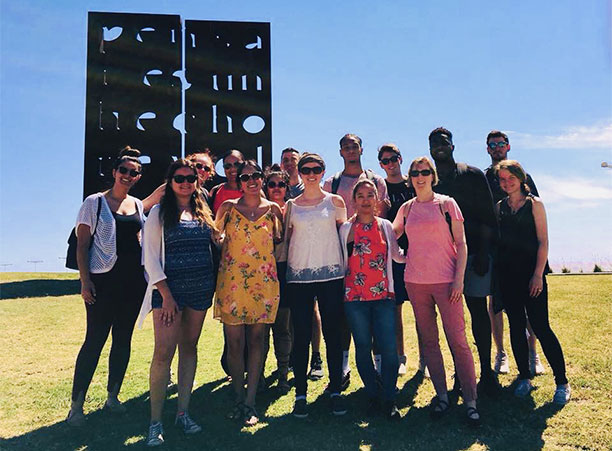
In the span of about a decade, roughly 30,000 people in Argentina disappeared at the hands of the government. Called "los desaparecidos," or "the disappeared," many of these individuals were brought to the 500-plus clandestine detention centers established to detain and torture those thought to be a threat to the country's dictatorship.
After spending the start of the spring semester studying this dark moment in Argentine history through film, Bridget Franco's Latin American Film class traveled to Buenos Aires over spring break to explore how these events and los desaparecidos are remembered a mere 30 years later.
In the course, taught entirely in Spanish, the associate professor of Spanish uses film as a way of both introducing her 14 students to what was happening in Argentina before, during and after the dictatorship and showcasing how art — specifically film — has reacted to these events. After exploring a range of cinematographic genres, from documentary to fictionalized drama, the students were able to directly step into the history they had been learning about on screen.
"A movie can move you to some point, but you can kind of dismiss it," says Mark Ebo '20 who was moved by the group's visit to the detention centers. "Actually being there and seeing the outline of the cells, seeing how small they were and knowing that four or five people sometimes shared those cells definitely hits you."
 Students visited ESMA, a well-known clandestine detention center, where Argentines continue to engage in protest. A sign in front of the center reads, "The only house for a genocide is the cartel." Photo by Teresa Murphy '19
Students visited ESMA, a well-known clandestine detention center, where Argentines continue to engage in protest. A sign in front of the center reads, "The only house for a genocide is the cartel." Photo by Teresa Murphy '19"I played soccer while in Argentina, and ESMA was on the highway that we took to our tournaments, but I never knew what it was until going back on this trip," Gregory shares. "It was a shock to learn that I had been driving by one of these centers every Saturday.
"It was also interesting to go to places where people actually did talk about the dictatorship, and were very open about it, because my host mom definitely wasn't," she adds. "Two of her cousins were desaparecidos, so she was very emotional about it and didn't talk about it."
In the classroom, Franco pushed her students to analyze how cinematography grapples with questions of representation, censorship, testimony and memory. In Buenos Aires, the class took these questions a step further as they explored how Argentina and its people support the collective memory of this period of their history today.
"Just walking by the Plaza de Mayo where the Madres de la Plaza march or seeing the graffiti on the city streets made me understand that this was not just another period that has come and gone in history, but one whose rippling effects are still being felt by an entire country of people," says Ryan Long '18.
The class visited Parque de la Memoria, a public park dedicated to remembering the victims of the dictatorship, where they walked along the River Plata, among memorial sculptures and past the 9,000 names of the documented desaparecidos.
"While at the park, we heard the airplanes from the military airport nearby," says Laura Lares '18, referring to the airport used during the dictatorship to fly victims over the river and sea where they were dropped to their deaths. "It makes you take a moment of silence, but it also makes you reflect. I now have this personal connection to this history and I have to do something. Now I have to discuss it and share the knowledge that I learned with people who don't know about what happened in Argentina."
"I think the students took away a much clearer understanding of how a traumatic moment in a country's history can affect the present day and how easily it can be forgotten if you don't take care of the memory," explains Franco.
 Four Holy Cross students holds signs that read "Together we are powerful" during the International Women's Day march in Buenos Aires. Photo by Bridget Franco
Four Holy Cross students holds signs that read "Together we are powerful" during the International Women's Day march in Buenos Aires. Photo by Bridget Franco"Politics are a lived experience in Argentina," says Franco, who was glad her students were able to get a taste of Argentine politics in action on such a large scale.
Having offered this course and accompanying trip three times, Franco has seen how beneficial the experiential component is for students — and for herself.
"I really enjoy being on this journey of discovery with my students because I myself went on that same journey," Franco shares. "By the end of the semester, we’re all going to have a better understanding of what we're studying, as well as a deeper and more personal connection to it. This is a part of what Holy Cross does — it supports education that reaches beyond the classroom walls and into communities that aren't easy to access, to get students outside their comfort zone and experiencing things first-hand."



